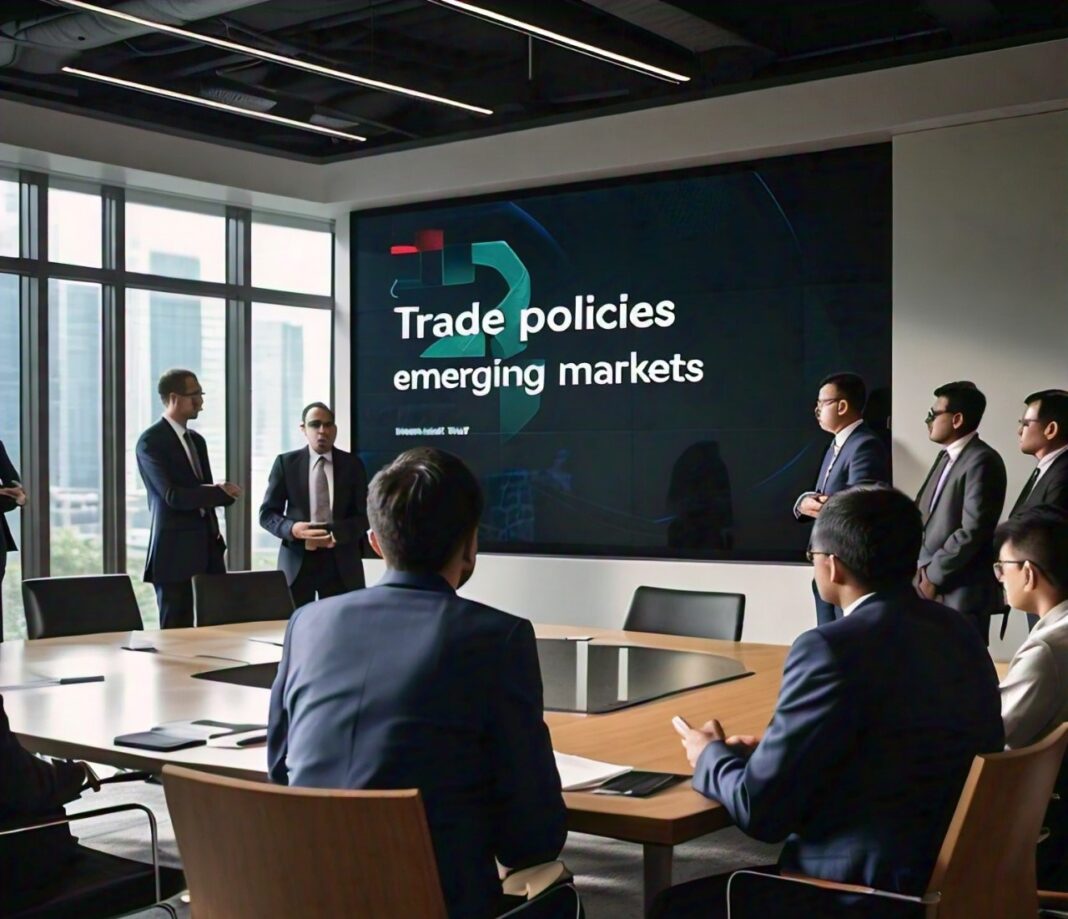Emerging markets have become increasingly influential in shaping global economic trends over the past two decades. Countries like China, India, Brazil, and Mexico have integrated deeply into global value chains, and their trade policies play a critical role in determining not just their own growth trajectories, but also the global economy. Trade policies in these markets serve as levers that influence a range of economic outcomes—most notably, economic growth, employment, and investment patterns.
For economists and researchers focusing on the intersection of trade policies and economic development, understanding these dynamics is essential. Trade policies in emerging markets are often designed to stimulate growth by promoting exports, attracting foreign direct investment, and developing competitive industries. However, these policies can also present challenges, especially when they are poorly implemented or fail to account for the complexities of global supply chains.
In recent years, as emerging markets increasingly exert global economic influence, their trade policies have generated both positive and negative spillovers across industries worldwide. For instance, faster growth in markets like India and Turkey has boosted certain sectors, while competition from low-wage economies like China and Mexico has disrupted industries in more developed countries (Trade Council)(IMF).
Moreover, the effectiveness of trade policies in stimulating growth has been mixed. Countries that have pursued open trade and investment policies often experience higher growth rates, as evidenced by stronger performance in Southeast Asia and parts of Latin America (S&P Global). However, protectionist measures and regulatory uncertainties can lead to growth stagnation, as seen in some regions where reforms have been delayed (IMF).
Understanding Trade Policies in Emerging Markets
Defining Trade Policies
Trade policies encompass a wide array of regulations and agreements that govern the flow of goods and services across borders. These policies include tariffs, import quotas, export incentives, trade agreements, and non-tariff barriers. In the context of emerging markets, trade policies can act as both drivers and deterrents of economic growth. The effectiveness of these policies is often dictated by the political, economic, and institutional landscape within each country.
Emerging markets tend to utilize trade policies as tools for economic development. By promoting exports, they aim to increase foreign exchange earnings and foster the growth of domestic industries. On the other hand, import tariffs or quotas may be employed to protect nascent industries from international competition. Countries like India and Brazil, for instance, have historically leaned on import substitution strategies to bolster domestic production (Trade Council). More recently, however, many emerging markets have shifted towards more liberalized trade environments to enhance competitiveness globally (IMF).
Also Read: Why Retail Sales Figures Are a Leading Economic Indicator

Key Factors Driving Trade Policy Formation in Emerging Markets
Several factors influence the trade policies of emerging markets, including:
- Political Stability: Governments in emerging markets must balance growth ambitions with maintaining political stability. Policies promoting openness or protectionism are often a reflection of the political climate.
- Economic Priorities: Countries often design their trade policies based on the needs of key industries or sectors they seek to promote, such as agriculture, manufacturing, or technology.
- Institutional Quality: Strong institutions ensure that trade policies are implemented effectively. Weak governance, corruption, and poor regulatory frameworks can undermine the success of trade reforms.
- External Pressures: International bodies like the World Trade Organization (WTO) and trade agreements influence emerging markets’ trade policies. Additionally, developed countries’ policies can create pressure to adapt.
These factors highlight the complexity of crafting trade policies in emerging markets, where local and global forces continuously shape decision-making. The ability of a country to navigate these dynamics often dictates its long-term economic success or stagnation.
The Relationship Between Trade Policies and Economic Growth
How Trade Policies Stimulate Economic Growth
Trade policies in emerging markets often aim to stimulate economic growth by encouraging exports, increasing access to international markets, and attracting foreign direct investment (FDI). Liberalized trade environments, such as those seen in countries like China, Vietnam, and Mexico, have proven effective in driving rapid economic expansion through several key mechanisms:
- Trade Liberalization and Market Access: Lowering tariffs and non-tariff barriers enables emerging markets to gain access to global markets. Export-oriented growth strategies, like those adopted by China and Vietnam, have resulted in significant GDP growth by leveraging low-cost labor and mass production capabilities(IMF)(S&P Global). These policies increase the competitiveness of domestic industries, providing them with the opportunity to scale up production and access larger consumer bases abroad.
- Attracting Foreign Direct Investment (FDI): Open trade policies often go hand-in-hand with policies that encourage FDI. Foreign companies are more likely to invest in countries where trade barriers are low, and where they can benefit from preferential trade agreements. Southeast Asian economies, particularly Vietnam and Thailand, have successfully used trade policies to attract investment from multinational corporations, boosting technology transfer, innovation, and job creation(S&P Global).
- Encouraging Industrial Growth and Innovation: Trade policies that facilitate the import of capital goods and intermediate inputs enable domestic industries to upgrade their production capabilities. As these industries modernize, they become more competitive on a global scale. For instance, in sectors like electronics manufacturing and automotive production, countries such as South Korea and China have moved up the value chain by utilizing open trade policies to foster innovation(S&P Global).
How Protectionist Policies Can Hinder Growth
While some emerging markets have thrived under open trade policies, others have implemented protectionist measures that have stifled growth. Protectionism—through high tariffs, import quotas, and subsidies to domestic industries—may initially appear to support local industries, but it often has negative long-term effects:
- Limited Competitiveness: Protectionist policies can insulate industries from international competition, which can result in inefficiency and complacency. Without exposure to global markets, local industries may lack the incentive to innovate, resulting in stagnant productivity. This has been seen in industries that rely heavily on government support, such as agriculture and heavy manufacturing in countries like Brazil and India (MF).
- Reduced Access to Global Supply Chains: By restricting imports, protectionist policies can limit access to essential inputs, technologies, and machinery that local industries need to grow. For example, industries in countries with high tariffs may struggle to participate in global supply chains, reducing their potential to export and scale (IMF).
Further Read: The Role of Currency Exchange Rates in Economic Forecasting
Evaluating the Effectiveness of Trade Policies in Emerging Markets
Measuring the Impact on GDP and Economic Growth
Trade policies in emerging markets can be evaluated through their direct impact on key macroeconomic indicators such as GDP growth, employment, and sectoral development. Countries with export-driven trade policies have experienced more robust economic expansion. For example, export-led growth strategies in East Asian economies, particularly in China and South Korea, significantly contributed to sustained high GDP growth rates over several decades (IMF)(S&P Global).
The correlation between open trade policies and economic growth is often attributed to improved market access, increased efficiency in production, and integration into global supply chains. Countries that have lowered trade barriers and pursued free trade agreements (FTAs) have generally seen a more consistent rise in GDP compared to those that adopt protectionist stances. Southeast Asian nations such as Vietnam and Thailand, for instance, have consistently outperformed their regional peers due to their trade openness (S&P Global).
On the other hand, countries that have implemented more protectionist policies have witnessed slower economic growth, especially in sectors reliant on international trade. Argentina’s fluctuating trade policies have resulted in cyclical economic crises, with restrictive trade measures often reducing competitiveness and limiting long-term growth (IMF).

Sector-Specific Growth and Development
Trade policies also have a significant impact on sector-specific development. Some emerging markets have successfully nurtured particular industries by adopting targeted trade measures. For example:
- Manufacturing: Countries like China and Mexico have effectively used trade agreements to promote their manufacturing sectors. By encouraging FDI and reducing import tariffs on key manufacturing inputs, they have turned into global hubs for electronics and automotive manufacturing(IMF).
- Agriculture: In contrast, countries like Brazil have focused on agricultural exports, becoming major players in global markets for commodities like soybeans, coffee, and sugar. However, trade restrictions in this sector often create inefficiencies. For instance, India’s tariff and subsidy policies in agriculture have limited the sector’s integration into global markets (Trade Council).
- Technology and Innovation: Technology sectors in countries like India and South Korea have benefited from policies encouraging exports and FDI, fostering innovation and enabling these countries to emerge as leaders in IT services and electronics manufacturing(S&P Global).
The effectiveness of trade policies in fostering sector-specific growth often depends on how well the policies align with the country’s competitive advantages and long-term economic goals.
Challenges and Policy Reforms
Emerging markets face unique challenges in implementing and sustaining effective trade policies. These challenges often include:
- Institutional Weakness: Poor governance and corruption can undermine the effectiveness of trade policies, particularly in countries with weak institutional frameworks. Trade policy reforms in countries like Argentina and South Africa have often been slowed down due to political instability and institutional inertia(S&P Global).
- Global Economic Conditions: External factors, such as changes in global demand or fluctuations in commodity prices, can affect the success of trade policies. For instance, oil-exporting countries like Saudi Arabia have been vulnerable to changes in global energy prices, which have affected the impact of their trade policies on growth(S&P Global).
- Geopolitical Risks: Trade policies are also influenced by geopolitical factors, such as trade wars or regional conflicts. Emerging markets that are heavily reliant on exports to specific regions, such as Mexico’s dependence on U.S. trade policies, must navigate shifting geopolitical landscapes to maintain stable growth(IMF).
Analyzing the Effects of Trade Policies on Employment and Income Distribution
Employment Growth in Export-Oriented Economies
One of the most significant benefits of liberalized trade policies in emerging markets has been their impact on employment. Countries that have embraced open trade strategies—particularly those focused on export-led growth—have seen a marked increase in job creation, especially in labor-intensive industries such as manufacturing and agriculture. For instance, China’s rapid industrialization, driven by its export-focused trade policies, resulted in millions of jobs in the manufacturing sector, reducing poverty and improving living standards for a significant portion of its population (S&P Global).
Similarly, Vietnam’s participation in free trade agreements (FTAs) has boosted employment in its textile and electronics industries, contributing to a sharp decline in poverty rates. The inflow of foreign direct investment (FDI) in these export sectors has played a crucial role in creating job opportunities for low-skilled and semi-skilled workers (IMF).
However, the benefits of employment growth are not evenly distributed across all sectors or regions within emerging markets. Urban areas tend to benefit more than rural areas, as manufacturing and services industries are more concentrated in cities. This creates regional disparities in employment opportunities (Trade Council).
You can also Read: What is a Chartered Financial Analyst

The Role of Trade Policies in Shaping Income Distribution
While trade liberalization has boosted economic growth and employment, it has also led to significant shifts in income distribution, often exacerbating inequality in emerging markets. Trade policies that encourage exports and FDI tend to benefit sectors that are integrated into global markets, such as manufacturing, technology, and finance. Workers in these sectors—who are often urban and more skilled—tend to see higher wages and improved working conditions (IMF).
On the other hand, protectionist policies, especially those aimed at shielding traditional industries like agriculture and mining, can limit the benefits of globalization for lower-income populations. In countries like Brazil and India, for example, protectionist trade measures in agriculture have reduced competition, but they have also hindered the sector’s ability to modernize and become more competitive globally. This can lead to stagnant wages and reduced opportunities for workers in rural areas (Trade Council)(IMF).
Policy Recommendations for Enhancing Trade Effectiveness in Emerging Markets
Promoting Trade Diversification
Emerging markets should pursue trade diversification as a key strategy to reduce reliance on a narrow range of export goods or trading partners. By expanding the variety of products they export and the regions they trade with, countries can better insulate themselves from external shocks such as global demand fluctuations, commodity price volatility, and geopolitical tensions. For example, oil-dependent economies like Nigeria and Venezuela have experienced economic instability due to over-reliance on a single commodity (S&P Global).
To foster diversification, trade policies should encourage the development of new industries and value-added sectors, reducing dependence on primary commodities. Governments can support this by offering incentives for investment in innovation, technology upgrades, and education, fostering the growth of competitive industries in manufacturing, services, and technology (IMF).
Strengthening Regional Trade Agreements
Emerging markets can benefit from increased participation in regional trade agreements (RTAs). RTAs such as the African Continental Free Trade Area (AfCFTA) or the ASEAN Free Trade Area (AFTA) enable countries to access regional markets, promote intra-regional trade, and create integrated supply chains. These agreements also help smaller emerging economies leverage their collective market power, making them more competitive on the global stage (Trade Council).
By aligning trade policies with regional partners, emerging markets can streamline customs procedures, reduce tariffs, and foster closer economic cooperation, which can boost trade volumes, attract FDI, and create jobs (S&P Global).
Further Read: The Role of Business Investment in Economic Forecasting

Investing in Infrastructure and Trade Facilitation
Effective trade policies rely on well-developed infrastructure, including ports, roads, railways, and digital networks. Emerging markets with inadequate infrastructure face higher transportation costs, longer shipping times, and reduced competitiveness in global trade. Infrastructure development is essential to improving a country’s ability to participate in global supply chains and attract FDI (IMF)(S&P Global).
In addition to physical infrastructure, governments must invest in trade facilitation measures such as simplifying customs procedures, improving logistics services, and enhancing digital trade platforms. According to the World Trade Organization (WTO), efficient trade facilitation can reduce the cost of trade by up to 14.5% in developing countries (Trade Council).
Conclusion
Emerging markets are at a critical juncture in their development, and trade policies will continue to play a decisive role in shaping their economic futures. While globalization has opened new opportunities for growth, integration into global markets also presents challenges, including managing competition, addressing income inequality, and mitigating external shocks.
As the global trade landscape evolves, emerging markets will need to focus on building economic resilience through diversification and innovation. Moving beyond reliance on commodity exports or a single trading partner will allow countries to buffer themselves against external shocks and enhance their long-term growth prospects.
Finally, international cooperation and integration will be essential for the continued success of trade policies in emerging markets. Whether through regional trade agreements, multilateral organizations, or bilateral partnerships, collaboration will provide emerging markets with the tools to navigate complex global trade challenges. However, ensuring that the benefits of trade are distributed equitably—both across regions and within populations—will be key to fostering inclusive growth and maintaining social stability.






